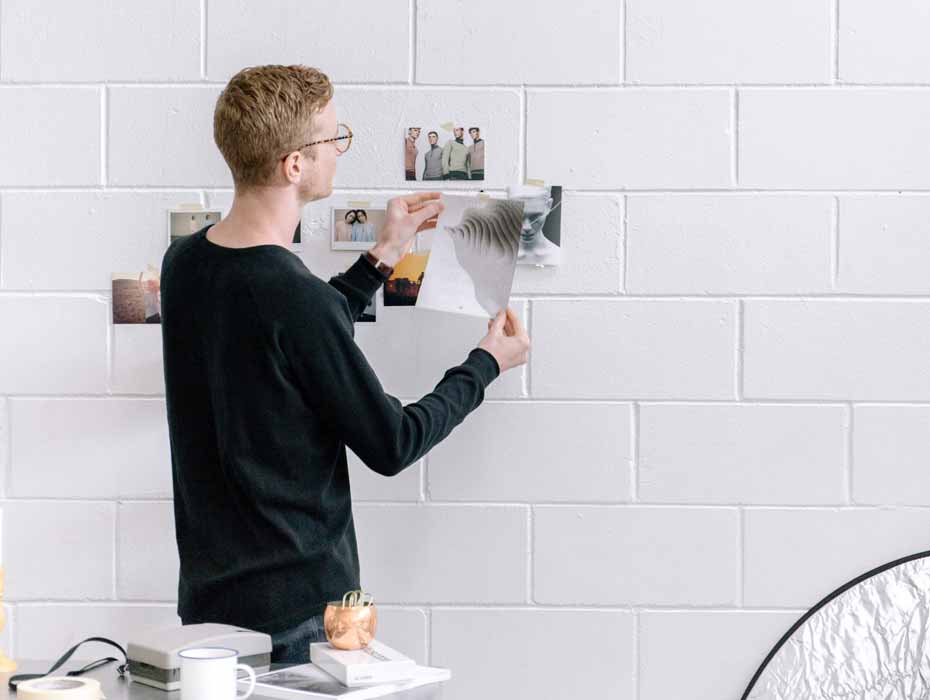Customers can seem completely unpredictable sometimes. They spend weeks researching your products, engaging with your content, and filling their cart—coming this close to finally making a purchase—just to abandon it before checking out.
Or they subscribe to your emails, click through to your product pages, learn more about your offerings, but never take that next step to buy.
You’re left sitting behind the scenes wondering what the heck they’re doing.
While some people really are just quick to changing their minds, customers not moving efficiently through your sales funnel could be a sign of a problem: you might not understand your customer journeys. For example, do you know how customers prefer to communicate with you after they’ve bought something from you (as opposed to before)?
Respondents in the 40-55 and 55+ age groups who were surveyed in the Customer Communications Review stated that phone calls were their preferred communication after a purchase. On the other hand, 18-39s actually preferred online chat and email over the phone:
Your customer journey explains how they get from Point A (not being a customer) to Point B (becoming a customer). But the progression is never really that linear. Instead, customers are often all over the place—bouncing from point to point, engaging with content along the way.
And what’s the best way to understand any kind of journey? A map. Here’s everything you need to know about customer journey mapping, including:
- What is customer journey mapping?
- Why should small businesses create customer journey maps?
- How to create a customer journey map in 5 simple steps
- Examples of different customer journey map types
🏃♀️ In a hurry? Get the 6 customer journey map templates right now👇

What is customer journey mapping?
Customer journey mapping is the exercise of visually outlining the process a prospect goes through to become a customer. That might be something as simple as signing up for a free trial or as involved as making an extravagant purchase.
Customer journey maps are typically just a rough outline of the possible directions a customer might move in. Because every person is different, you can’t predict the exact steps they might take to convert.
However, customer journey mapping can help you understand the thought processes, behaviors, and needs of your customers to prevent anyone from slipping through the cracks. Which leads to our next point.
Why do you need a customer journey map?
A customer journey map breaks down the conversion process into individual phases. Rather than just looking at the end destination as the only goal, a customer journey map allows you to visualize the many small decisions your customers make to eventually become a customer.
You’re then able to narrow your focus and deliver the right resources at the right time—converting customers more quickly and preventing prospects from getting neglected.
Creating customer journey maps can also help you make fundamental improvements to your business:
- Get to know your target audience. Understanding your customer journey comes with getting to know your audience better. You’re analyzing their decisions, thinking about their needs, and putting yourself in their shoes. With that research, you gain more knowledge about who your target audience really is and the customer experience they’re looking for.
- Create an inbound-first marketing model. Inbound marketing campaigns bring leads to you rather than you needing to hunt them down yourself (as you would with outbound marketing strategies like cold calling). When you know your target audience well, you can create inbound calling strategies that bring them to you.
- Adopt a customer-centric strategy. Customer-centricity should be an organization-wide initiative—but you can’t deliver this if you don’t really know who your customer is. Creating customer journey maps gives every department—sales, marketing, product development, service—a better understanding of who they’re connecting with.
In short, customer journey maps just help you do business better. Rather than guessing what your customer needs, you know what they need—and how to give it to them.
Next steps? You need to create your unique map.
How to create a customer journey map in 5 steps
Customer journey mapping looks slightly different from company to company. Your customers, products and services, and resources available will all influence this process.
While every map will look different, there are some fundamental, systematic steps you can take—starting with why you need a map in the first place.
We’re going to map this out in a spreadsheet. You can more easily follow along if you do the same! You can download a template of the customer journey map spreadsheet below—feel free to edit it based on what you need.
1. Establish your objectives
The first thing you need to do is answer the question of why? Why are you creating this customer journey map?
This might seem like a trick question. After all, we did just give you a bulleted list of why you should care about customer journey maps, but we’re looking for an answer a little deeper than that.
What are you hoping to accomplish by mapping out this customer journey? What are the individual steps and goals you want the customer to complete? What resources do you need to share with the customer at each point? Set a clear goal for yourself.
Think about how this behavior from the customer will translate into the larger business objectives you’re trying to accomplish. For example, you might want to reduce churn and convert more past customers. Maybe you need to boost sales or sell more of a specific product or service.
Knowing your objectives can help you identify potential problems in your current customer journey (but more on that later).
In the first line of your spreadsheet, write out your objective.
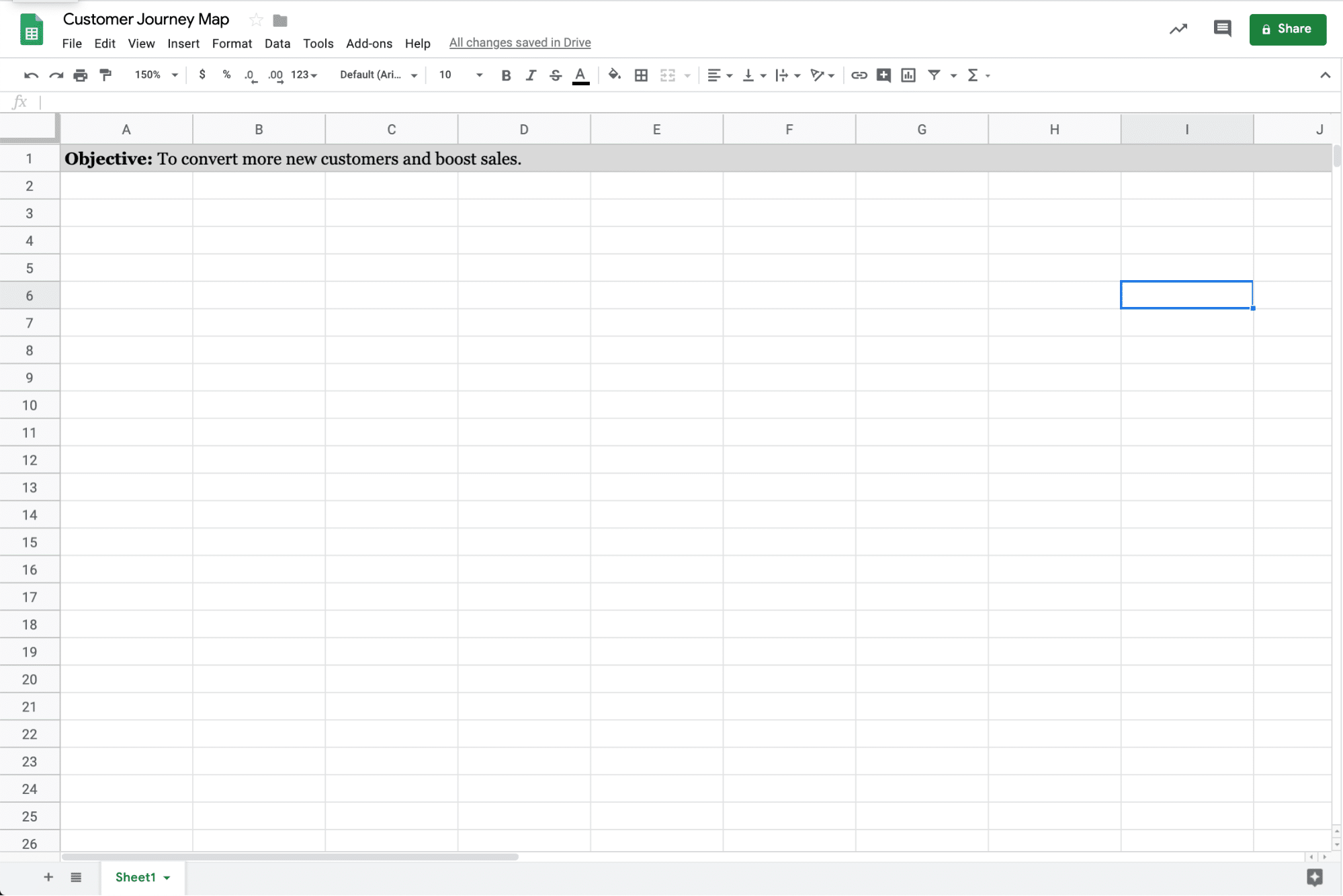
2. Create and highlight your target personas
Creating customer personas is the very first step in getting to know your audience better. A customer persona is a fictional representation of your ideal customer, including demographics and psychographics.
If you haven’t already created customer personas, take a step back and outline all your different types of customers, who they are, and what they might be looking for—both from your brand and from other businesses they engage with.
Here are some questions your buyer personas should address:
- What are your customers’ job titles and responsibilities?
- Where are they located?
- What hobbies, activities, or organizations do they partake in?
- Are they the decision-maker for buying your product? If not, how do they connect with the decision-maker?
- What challenges are they facing?
- What solutions have they already tried to solve those challenges? Where did those solutions come up short?
- What are they interested in learning about from you?
- What are the most important factors when they’re deciding to make a purchase?
You’ll have a few customer personas, and you can’t target them all with one customer journey map. Each persona will likely have a different customer journey depending on who they are, their budget constraints, problems they’re facing, and solutions they’ve tried. Now is the time to identify the personas relevant to the customer journey map you’re creating.
You’ll need to look back at your objectives here. What did you say you wanted to accomplish, and who is most likely to complete that task? If this is the first customer journey map you’re creating, just focus on one persona for now.
Establish your target persona and some key details about who they are right below the objective line in your spreadsheet. Having this info clearly visible throughout the customer journey mapping process will help you stay focused.
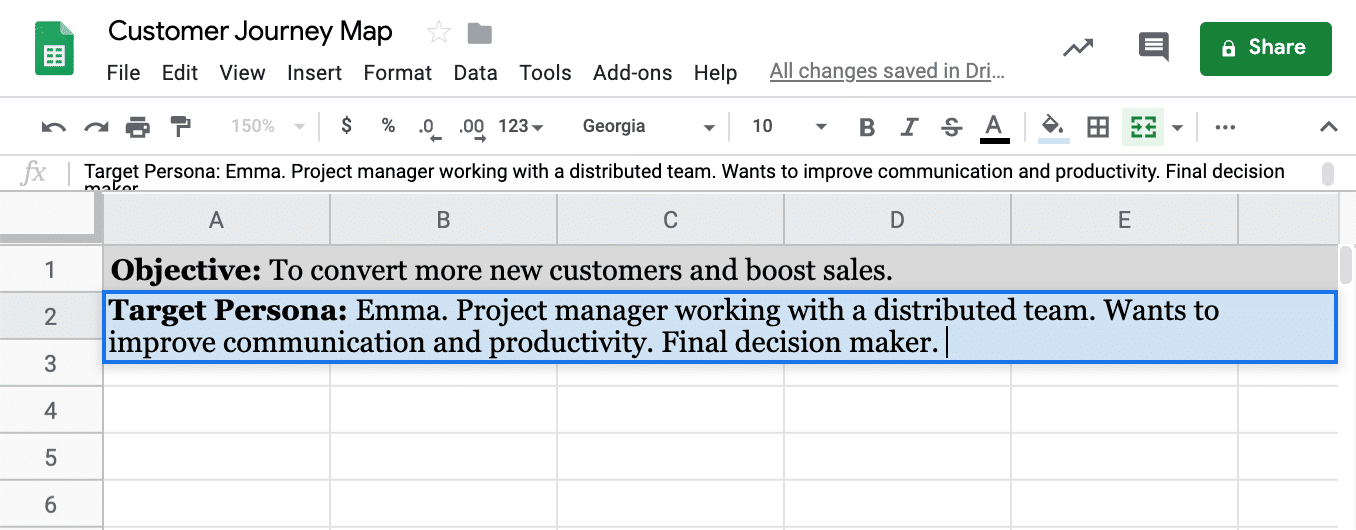
3. Know your customer lifecycle phases
Although customer journey maps differ from brand to brand, customers tend to follow similar processes:
- Awareness: Discovering your brand and the solutions you provide
- Research: Learning more about your business and what you have to offer, and determining if you have the right solutions to solve their problems
- Consideration: Comparing your brand with competitors to see which offers the right solution for their unique needs
- Purchase: Making a final selection and buying (or otherwise converting, such as reaching out through email or phone call)
Add a section for each stage to your spreadsheet.

Understanding these different phases and what happens at each one sets the framework for mapping out your customer journey.
Think about what your goal is at each stage of the customer lifecycle. What action or behavior would move them to the next phase? What are their unique needs at this phase? What questions might they be asking?
These questions are the next thing to answer in your spreadsheet:

Finally, consider what your goals as a business are at each stage. What do you want to provide your customers to move them through the customer journey?

4. Map out your touchpoints
A touchpoint is any place where your customer engages. This could be through your website, an email marketing campaign, social media, third-party review sites, or over the phone—anywhere they can get in touch with you.
There are likely a number of different touchpoints between your customer and your brand, but not all of them will be relevant to your customer journey map.
Different touchpoints typically go with different phases of the customer journey. For example, social media interactions are more prevalent during the awareness stage while customer reviews or blog posts might not be looked at until the customer is in the consideration phase. (Learn about more social media benefits.)
Map out your touchpoints by breaking down your customer journey into the phases in Step 3, starting with awareness.
Identify the specific profiles or platforms the customer might go through at the awareness stage. This might include social media or posts from influencers or media websites.
Add this to your spreadsheet:
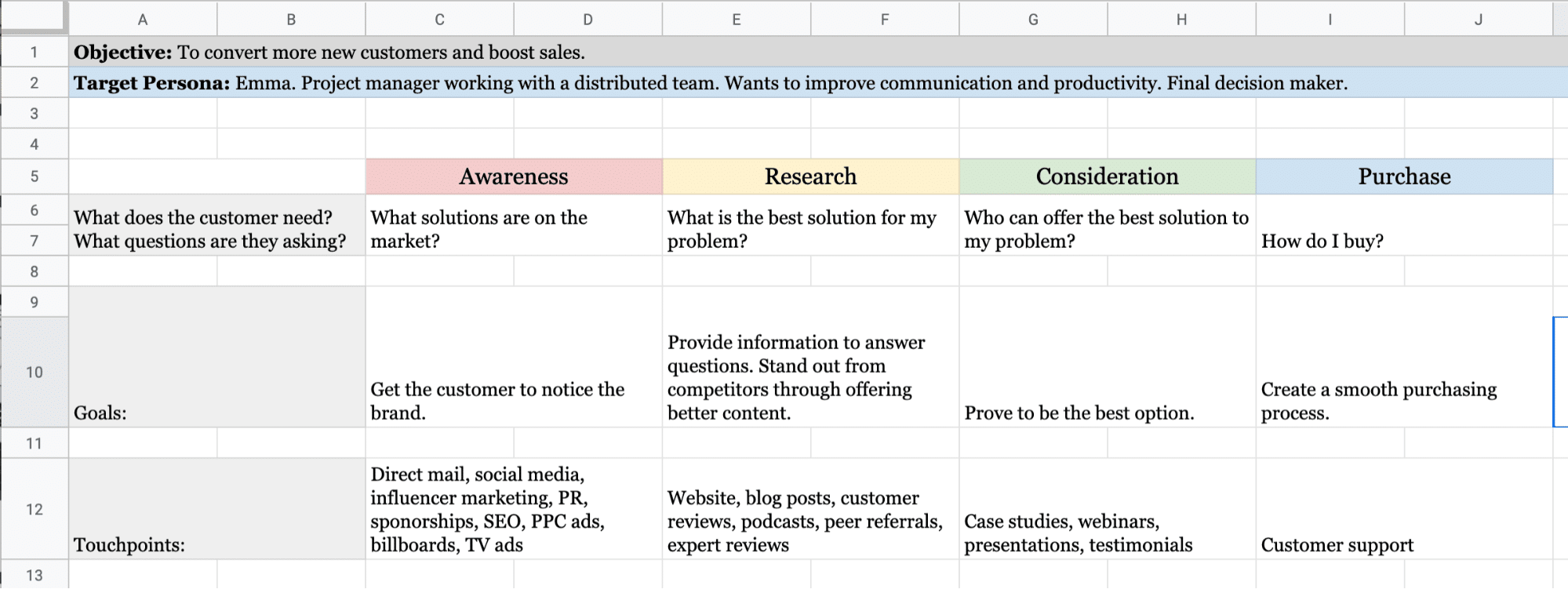
Now give some context to those actions. What is the customer doing at this stage? What might they be thinking or feeling? Think about the emotional side (like anxiety and excitement) of the transaction as well.
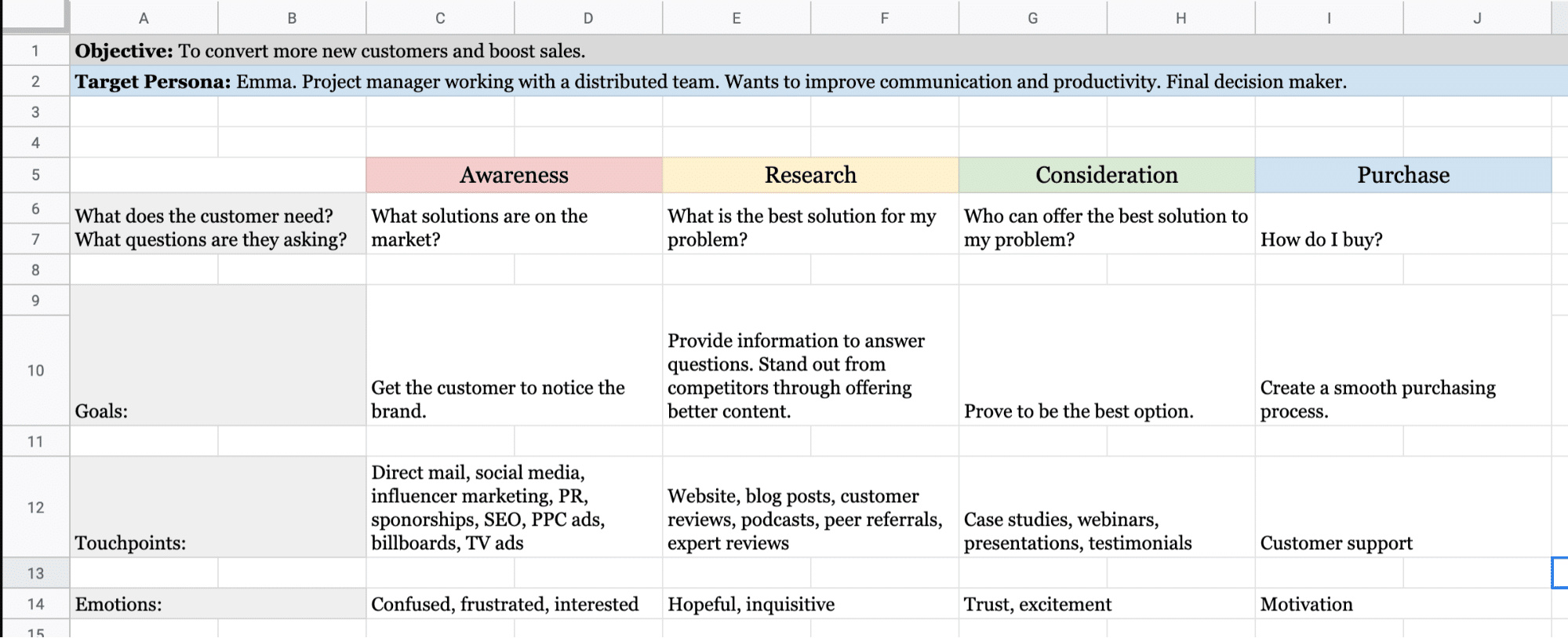
Follow this process all the way through to the end, outlining where the customer is getting in touch at each phase, as well as what they’re doing, thinking, or feeling.
5. Find the gaps and fill them
If your customer journey were perfectly established already, you wouldn’t be here. Customers are falling through somehow, somewhere, and you need to find out why.
Talk with customer-facing team members.
No one knows your customers’ frustrations better than your support team members. They interact with customers daily—responding to problems, answering questions, collecting feedback—so why not ask them what it is they’re hearing?
Here are some questions you can ask your team:
- What problems do you hear most frequently from customers?
- What roadblocks or challenges have customers experienced in the past?
- What emotions are they typically feeling when they reach out? Are they supportive, frustrated, confused?
- What questions do they typically ask?
- What experiences do customers seem to enjoy or are impressed by?
These can help get the conversation flowing.
Use the right communication tools to make it easier for customer support team to share information with other teams. Knowing customer reactions in real-time can keep your customer journey maps strong. One way to do this is through a team messaging app. For example, RingCentral’s team messaging platform makes it easy to share files, relay messages, or just connect on customer challenges or feedback:
For most businesses, your customer-facing team will need a way to quickly and efficiently keep you updated if new or unexpected problems appear.
Go straight to the source.
While your support team probably has some useful information, they’re only able to gather insights and data about the customers they’ve connected with. If customers leave the customer journey before feeling invested enough in your brand to reach out, you might never know what they think.
Up until this point, you’ve just been making educated guesses about customer needs, behaviors, and thought processes. Maybe you’ve used data and analytics to back up your points, but it’s still reactive.
That’s why you need to go straight to the source—your target audience.
Talking with your customers and prospects through interviews, surveys, and questionnaires can affirm or challenge the assumptions you’ve made. Here’s how:
1. Identify the audience group and how you’re going to connect. Who are you going to talk to and how? This might be social media followers, past customers, people who’ve abandoned full carts—or all three! Establish who you want to hear from and how you’re going to get in touch.
If your phone system has an auto dialer (or other calling features), it can help you connect with large groups of customers, getting more reliable information more quickly for your customer journey map.
2. Create your questions. Once you have their attention, figure out what you’re going to ask. Keep it short—3 to 5 questions for prospects and maybe 5 to 10 for established customers. Questions you might ask include:
-
-
- What made you choose/not choose to purchase from us?
- What problem or challenge were you hoping the product/service would solve?
- Did you struggle to find any information about the product/service or the brand? What information was it?
- What could have made the buying process easier?
- How could we improve the customer experience?
-
3. Collect responses and look for patterns. Every customer will likely have a different experience, but similar groups might have similar reactions. Look for patterns in your customers’ and prospects’ responses. If they all outline the same problem with your buying process, you know your map has some gaps.
Follow the customer journey map yourself.
Your customer service team and the customers themselves should have given you some decent insights, but nothing beats the first-hand perspective.
After implementing changes to your customer journey map based on the information you’ve collected, it’s time to follow the map yourself.
Pretend you’re a customer interested in your products or services. Follow the progression of touchpoints you established to move through the awareness, research, consideration, and purchasing stages.
At each point, analyze if you feel you have enough information or not. Do you have any questions that haven’t been answered, or do you feel like something is missing? There might still be some gaps that haven’t been identified yet.
If you feel like you’re too close to the customer journey and content available to get a good read, ask someone outside your circle to follow the process—a friend or family member who might not be a customer or involved with the business.
Examples of customer journey maps
Need a little more inspiration? Here are some examples of customer journey maps you can pull from.
1. Business to business (B2B) buyer journey maps
Let’s start out with a pretty basic customer journey map. If you’ve been following along with our spreadsheet, your customer journey map probably closely resembles this example:
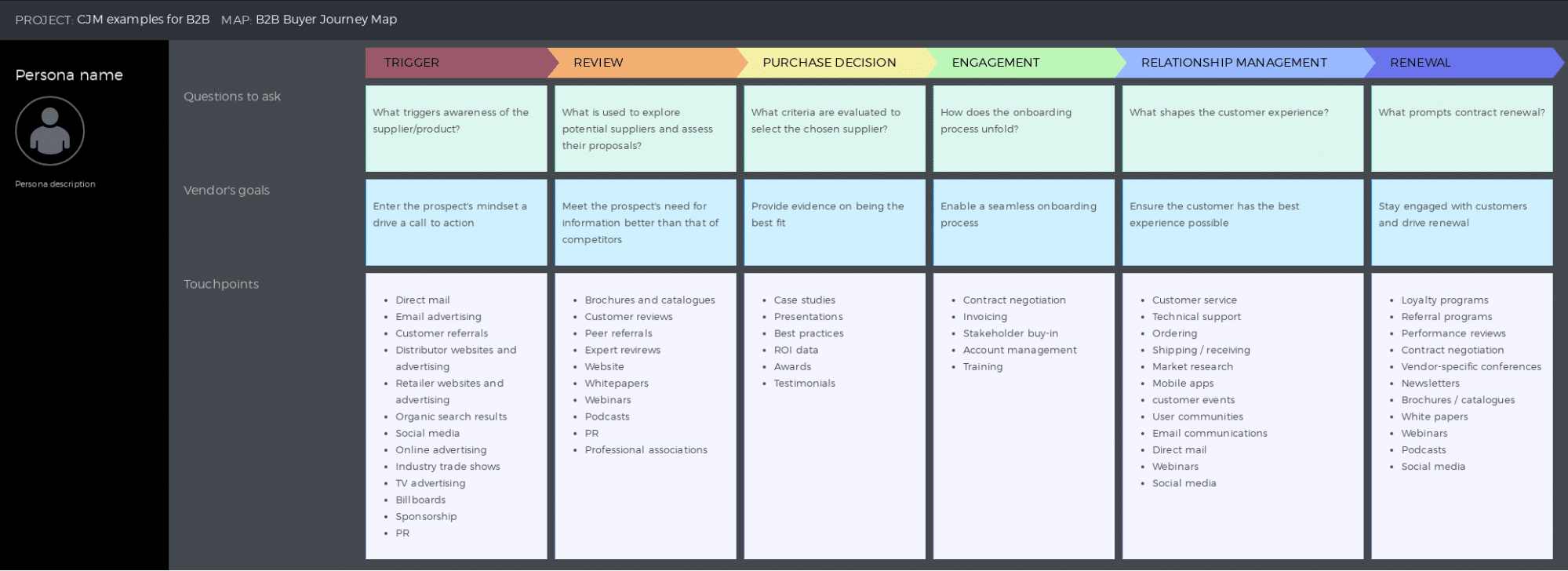
It’s simple and to the point. If you’re new to customer journey maps, a clean, basic flow is easy to understand and gives you all the information you need at a quick glance.
When you’re a business that sells to businesses (B2B), the buyer is rarely just one person. While a single person might be the final decision-maker, a B2B purchasing decision often involves multiple people giving their approval, meaning the entire cycle can take a bit longer. (Sometimes months!)
Here’s another great example of a basic B2B customer journey:
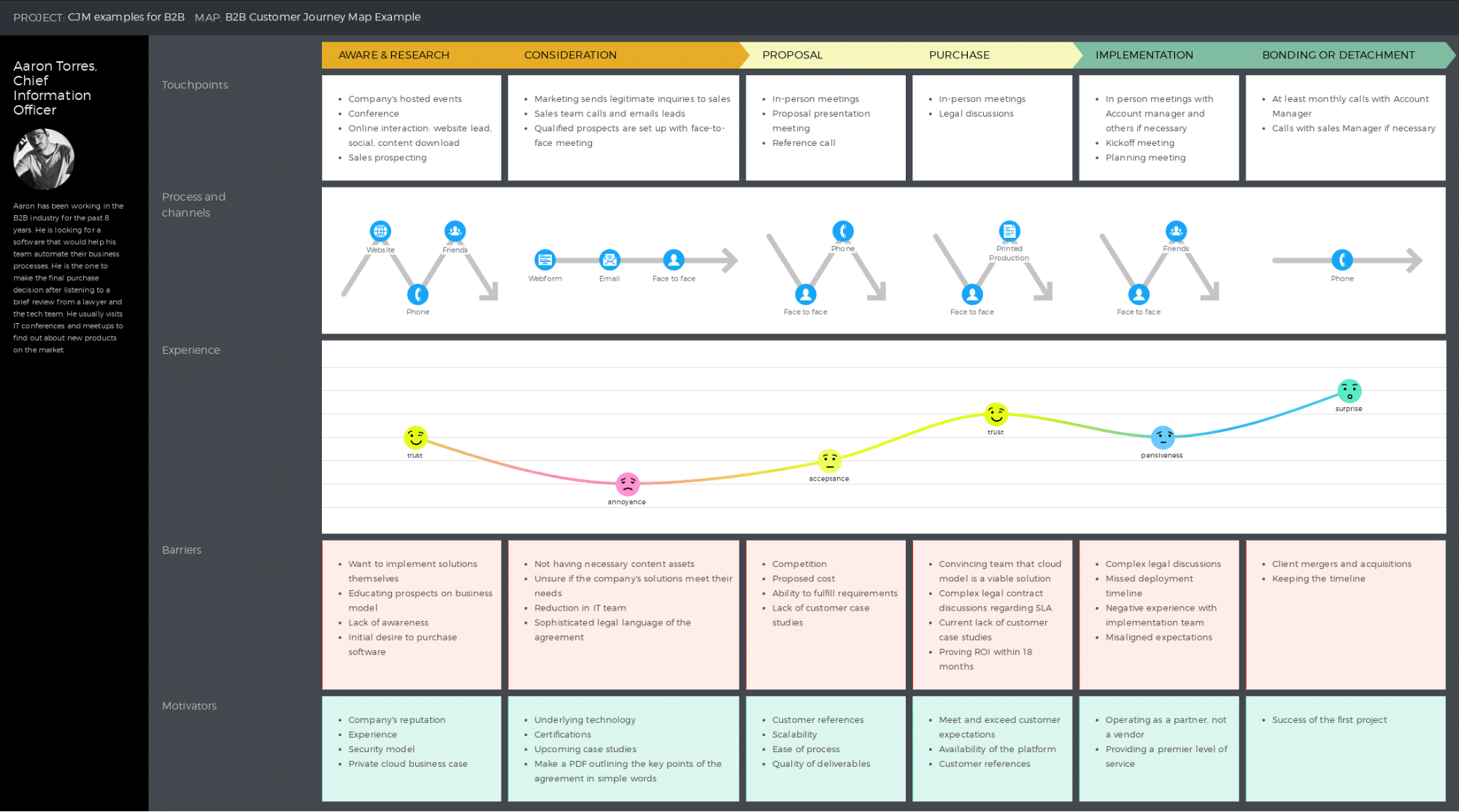
While it’s a little more in-depth, it’s still easy to read for your entire team.
As we see in both of these customer journey maps, the phases of the purchasing journey go beyond just awareness, research, consideration, and purchase, yet there are content recommendations and goals at each step. If you feel like you need to take up more space or more steps, go with your gut.
Key takeaways:
- Don’t overdesign for the sake of looking cool. A basic guide like this one gives you all the information you need in an easy to read and understand package.
- Expand your customer journey map so it feels right for you. If your customer needs more phases to get through their journey, that’s totally fine.
2. Software as a service (SaaS) buyer journey maps
Your customer journey map should show a progression of how your customer moves through the buying process. The SaaS buyer’s journey is unique because much of the journey is still continuing after the decision is made. Because SaaS business models are built on the hope that the customer keeps returning, you need to think about the customer’s experience beyond just the initial purchase.
This example of a SaaS customer journey does a great job of showing the seamless movements, thoughts, and feelings of customers at different stages of buying subscription software:
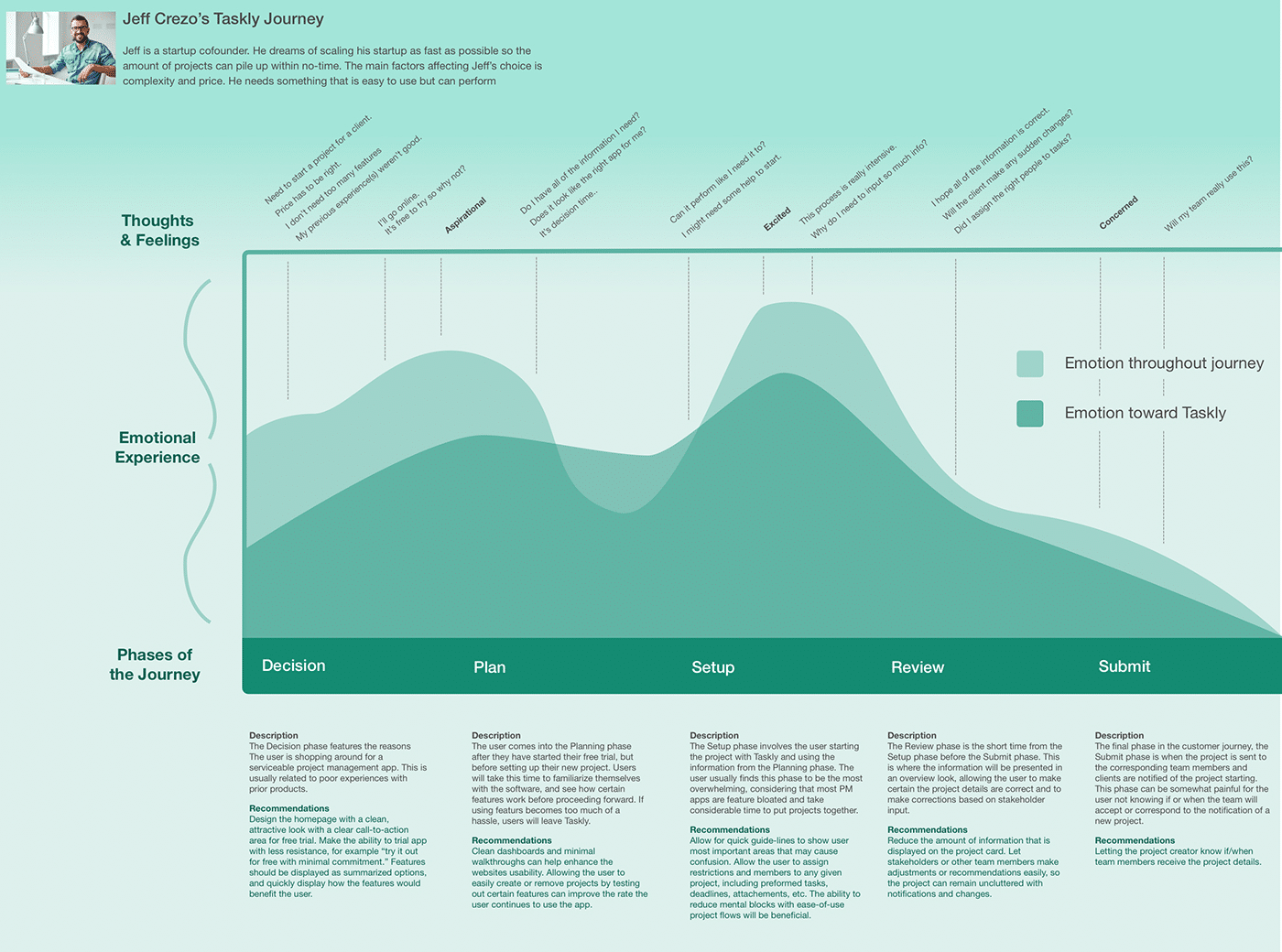
They also give solid descriptions with recommendations for approaching each phase of the journey.
Key takeaway:
- Remember that the journey is fluid. The ending of one phase should transition smoothly into the next, so consider what the customer might be experiencing at all points of the customer journey.
- Don’t assume your customer journey ends when they make their first purchase. If you need the customer to convert again, create a journey map that represents that process.
3. In-store shopping buyer journey maps
Customer journey maps don’t discriminate between online or in-store purchases. If you’re a retail store, you still need to outline the various touchpoints, emotions, and customer needs.
Here’s an example from the grocery store The Fresh Market:
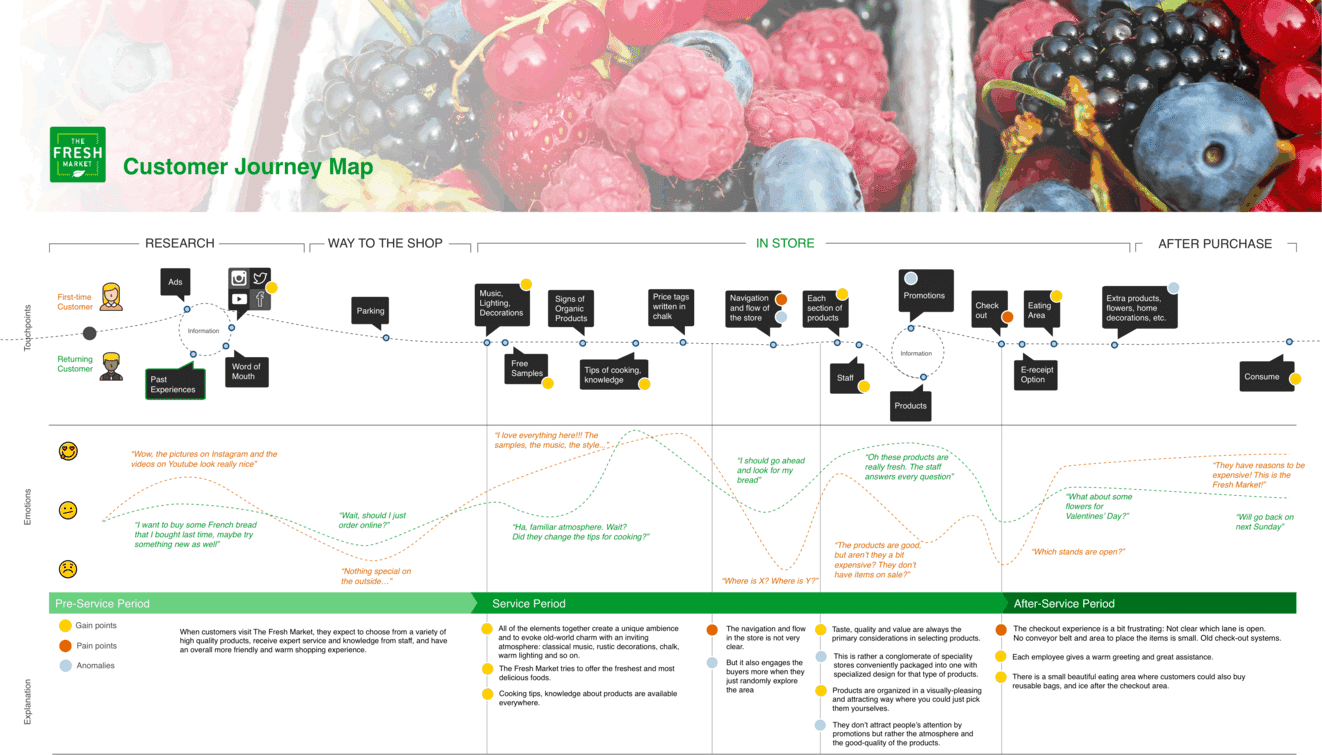
One great thing about this customer journey map is that they’ve laid out the emotions and experiences for both returning customers and first-time customers. This comparison shows how two different customers can have similar—or very different—experiences.
Be sure to focus an equal amount on the research and pre-shopping connections as much as the in-store touchpoints. Your customer journey doesn’t begin when the customer walks in the door, and they’re not committed to purchasing once they get inside. Make sure your customer journey map represents the full picture.
Key takeaways:
- Look at the same journey from different perspectives. Don’t assume a customer will have the same experience every time they buy from you.
- Remember the full customer journey. Although they’re shopping in store, the customer journey begins long before.
4. Online learning buyer journey maps
Sometimes the end goal isn’t to make a purchase at all, but instead to educate a customer about a general topic or just provide some information.
Here’s an example of a customer journey map for bringing information to customers from USA.gov.
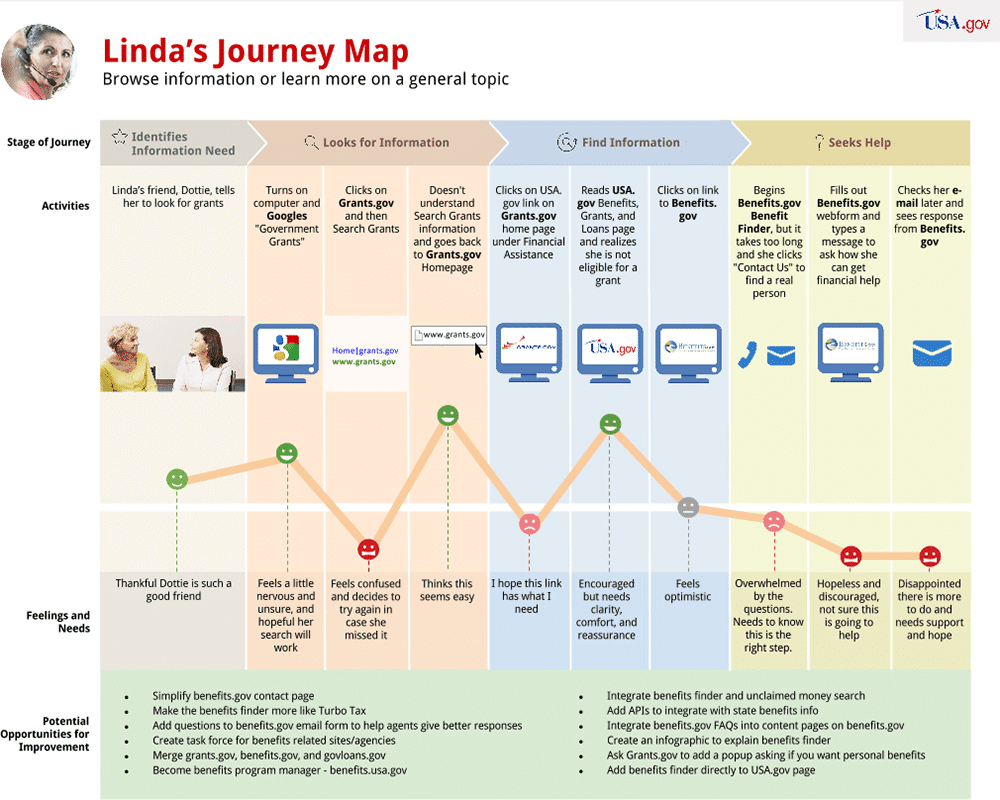
Notice how it more or less follows the same steps.
Treat an online learner the same way you would a traditional buyer. While you may not need them to take out their credit card to become a customer, you still want them to connect. Don’t discredit education customer journey maps just because they don’t end in a purchase.
Key takeaways:
- If you have a non-traditional end goal, customer journey maps are still important. Follow the same steps by outlining emotions, feelings and needs, and activities performed.
5. Multichannel buyer journey map
Our customers rarely engage with content and brands in just one way. They’re searching for omnichannel content that brings them through the customer journey at various points of their daily lives. By following the customer through the different channels—on mobile, at home, and in store—you can ensure your audience is appropriately targeted at every step.
Here’s an example of a customer journey map that displays this process:

Make sure to plan for the transitions. Don’t assume your customer will seamlessly move from one channel to the next. It’s your responsibility to find ways to connect with your customers through their favorite channels.
Key takeaway:
- Recognize how your customers engage with content in different ways. While they might be targeted online, they might eventually move to buy in-store. Create a customer journey map that meets all these needs.
Ready to create a customer journey map of your own?
Now that you have all the pieces to create a customer journey map, you’re ready to get started!
But mapping out the customer journey is just the first step. Once you create your map, you need to apply it to your business model, content, and deliverables to create a better customer experience for your audience.
And it shouldn’t stop there. Just like your buyer personas and marketing campaigns, customer journey maps require consistent revival. Come back to your customer journey map every few months to see if it’s still relevant.
While you don’t need to start from scratch, moving through these steps and looking at examples of customer journey maps other brands have created can give you inspiration and insight to dig deeper. As your customer journey maps get more detailed, you can build stronger connections with your audience.
Originally published Feb 01, 2020, updated Feb 07, 2022





